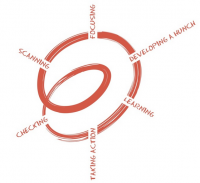Breaking down walls to develop a collaborative modern learning and teaching space
Tags: Teacher inquiry | BYOD | Middle primary | Primary |
South New Brighton School teacher, Kurt Soares developed a collaborative modern learning and teaching space with his year 3-4 students.
Background
Located in the eastern suburbs of Christchurch, South New Brighton School was damaged during the Canterbury earthquakes of 2010-2011. As a result the school will have a partial rebuild in 2015. For Principal John Bockett and the teaching staff, this prompted inquiry in to future focused learning and teaching .
To support their inquiry, John organised a series of learning and development opportunities for the staff. This included:
- a team of five staff participating in a facilitated modern learning environment tour of schools in Melbourne (this experience provided a foundation for dialogue and reflection on how a rebuild might transform learning at South New Brighton School)
- regular staff meetings specifically focused on unpacking future-focused learning including discussion on modern learning environments and pedagogy
- a tour of schools in Christchurch implementing modern practice for all staff
- a Principal visit to a new build school in Wellington
- teachers being mentored through a teacher inquiry in to developing a collaborative modern learning environment as part of the Future Focus Inquiry programme.
Beginning the inquiry
As part of his participation in the Future Focus Inquiry programme, Kurt Soares (team leader and teacher of a year 3-4 class) used Halbert and Kaser’s Spirals of Inquiry (2013) framework to inquire into developing a collaborative modern learning and teaching space.
Learning spaces and student voice
Kurt asked students to think about their learning processes and what kind of spaces would support them. He used a series of questions designed to stimulate thinking about learning including:
- How do I learn best?
- What technologies can I use to support learning?
- What spaces are needed to help me work in this way?
- What hopes and fears do I hold for the proposed new learning space?
Students identified spaces they needed for learning and worked with Kurt to redesign the learning environment utilising only existing resources. Incorporating student voice in this process provided students with agency and ownership of their learning space, evidenced in the way they care for their environment and take responsibility for their learning.
Students followed a design process and created a variety of learning spaces based on the school vision, which is to be a community of quality learners nurturing the values of citizenship, achievement, responsibility, and effort.
"I love that we designed our own spaces and can work in a space that suits us."
"I like that I can go way down the other end of the room if I need a change from our end."
"It's cool that we have games, iPads and laptops from 2 classrooms. There's heaps more to choose from!"
Year 3-4 students at South New Brighton School
Team teaching
Knocking down a wall between the two 1960’s classrooms not only opened the space to one big room, but it also opened up the possibility for teachers to team teach.
Kurt and his colleagues' journey into team teaching started small. Initially, they planned one shared maths session per week combining the two classes. During the next three months, team teaching became fully integrated across all curriculum areas for most of the day. Kurt reflects on the development of a collaborative team-teaching approach and the importance of student voice in this process in his blog, My MLE journey .
Student voice was a strong influence, with students commenting on how they learned better with this approach.
"I've enjoyed having 2 teachers to help me. If one is busy, the other one can help when I need it."
"I like how the teachers are good at different things they can teach us. Like Kurt is good at art and Kirsty (South New Brighton school teacher) is good at sport."
"I like that I can work with different people from another class."
Year 3-4 students at South New Brighton School
While initially tentative about teaching together, the teachers found that they enjoyed the support of planning and teaching collaboratively. They drew on each other’s areas of strength, and could personalise learning for students.
“Regular collaboration and discussion has improved teacher growth. We are learning from each other all the time and our professional knowledge has grown at a rate that otherwise wouldn't happen in a 'single cell' environment.”
“Through strategic grouping of children, we have been able to address a greater number of learning needs. We have been able to devote more focused teaching time to the areas of greatest need.”
Kurt Fletcher
Kurt observed that working in this way was making a difference to student learning and behaviour. He expected an upward shift in student achievement as a result. Other staff commented on the positive changes.
“Every student knows what they are doing. It is a focused working atmosphere. While not soundproof….no noise issues. Calm buzz of happy working kids.”
Janene Gill – Deputy Principal
Gathering voice
Connecting with the community to ask what they wanted for their children was an important aspect of rethinking the learning environment. This meant building on existing relationships with the parent and school community, to determine the school vision. The process included rebuilding connections with other schools and early childhood services in the area to work together more closely. Ongoing consultation and communication is an important part of Principal, John Bockett’s leadership.
The recognition of internal and external voice will guide a positive transformation of South New Brighton School.
